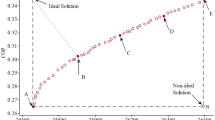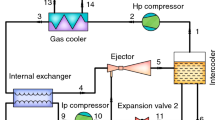Abstract
This research paper aims to perform dynamics analysis, 3E assessment including energy, exergy, exergoeconomic, and the multi-objective evolutionary optimization on a novel solar Li-Br absorption refrigeration cycle. The research is time-dependent, owing to solar radiation variability during different timelines. Theoretically, all the necessary thermodynamic, energy, and exergy equations are applied initially. This is followed by the thermoeconomic analysis, which takes place after defining the designing variables during the thermoeconomic optimization process and is presented together with the economic relations of the system and its thermoeconomic characteristics. Furthermore, the sensitivity analysis is undertaken, the source of system inefficiency is determined, the multi-objective evolutionary optimization of the whole system is carried out, and the optimal values are compared with the primary stage. Engineering Equation Solver (EES) software has been used to accomplish comprehensive analyses. As part of the validation process, the results of the research are compared with those published previously and are found to be relatively consistent.
Similar content being viewed by others
References
Alahmer A, Ajib S. Solar cooling technologies: State of art and perspectives. Energy Convers Manage, 2020, 214: 112896
Ortiz-Imedio R, Ortiz A, Ortiz I. Comprehensive analysis of the combustion of low carbon fuels (hydrogen, methane and coke oven gas) in a spark ignition engine through CFD modeling. Energy Convers Manage, 2022, 251: 114918
Lickley M, Solomon S, Fletcher S, et al. Quantifying contributions of chlorofluorocarbon banks to emissions and impacts on the ozone layer and climate. Nat Commun, 2020, 11: 138
Vollmer M K, Mühle J, Henne S, et al. Unexpected nascent atmospheric emissions of three ozone-depleting hydrochlorofluorocarbons. Proc Natl Acad Sci USA, 2021, 118: e2010914118
Moura D M D, Araújo A M M, Souza K B, et al. Hydrofluoric acid concentration, time and use of phosphoric acid on the bond strength of feldspathic ceramics. Braz oral res, 2020, 34: e018
Benedick R E. Montreal Protocol on substances that deplete the ozone layer. Int Negot, 1996, 1: 231–246
Su B, Han W, Jin H. An innovative solar-powered absorption refrigeration system combined with liquid desiccant dehumidification for cooling and water. Energy Convers Manage, 2017, 153: 515–525
Zhao H, Jiang T, Hou H. Performance analysis of the SOFC-CCHP system based on H2O/Li-Br absorption refrigeration cycle fueled by coke oven gas. Energy, 2015, 91: 983–993
Zheng S, Li C, Zeng Z. Thermo-economic analysis, working fluids selection, and cost projection of a precooler-integrated dual-stage combined cycle (PIDSCC) system utilizing cold exergy of liquefied natural gas. Energy, 2022, 238: 121851
Xu Z Y, Wang R Z, Xia Z Z. A novel variable effect LiBr-water absorption refrigeration cycle. Energy, 2013, 60: 457–463
Muye J, Praveen Kumar G, Bruno J C, et al. Modelling of scroll expander for different working fluids for low capacity power generation. Appl Thermal Eng, 2019, 159: 113932
Zacarias A, Quiroz J A, Gutiérrez-Urueta G L, et al. Comparison between adiabatic and nonadiabatic absorption chillers using ammonia-lithium nitrate and water-lithium bromide solutions. Heat Trans Res, 2020, 51: 609–621
Lee G, Choi H W, Kang Y T. Cycle performance analysis and experimental validation of a novel diffusion absorption refrigeration system using R600a/n-octane. Energy, 2021, 217: 119328
Lima A A S, Leite G N P, Ochoa A A V, et al. Absorption refrigeration systems based on ammonia as refrigerant using different absorbents: Review and applications. Energies, 2021, 14: 48
Yin L, Ju Y. Conceptual design and analysis of a novel process for BOG re-liquefaction combined with absorption refrigeration cycle. Energy, 2020, 205: 118008
Ghorbani B, Ebrahimi A, Moradi M, et al. Continuous production of cryogenic energy at low-temperature using two-stage ejector cooling system, Kalina power cycle, cold energy storage unit, and photovoltaic system. Energy Convers Manage, 2021, 227: 113541
Mohtaram S, Chen W, Zargar T, et al. Energy-exergy analysis of compressor pressure ratio effects on thermodynamic performance of ammonia water combined cycle. Energy Convers Manage, 2017, 134: 77–87
Mohtaram S, Chen W, Lin J. Investigation on the combined Rankine-absorption power and refrigeration cycles using the parametric analysis and genetic algorithm. Energy Convers Manage, 2017, 150: 754–762
Mohtaram S, Lin J, Chen W, et al. Evaluating the effect of ammonia-water dilution pressure and its density on thermodynamic performance of combined cycles by the energy-exergy analysis approach. Mechanics, 2017, 23: 209–219
Shabir F, Sultan M, Miyazaki T, et al. Recent updates on the adsorption capacities of adsorbent-adsorbate pairs for heat transformation applications. Renew Sustain Energy Rev, 2020, 119: 109630
Wu X, Xu S, Jiang M. Development of bubble absorption refrigeration technology: A review. Renew Sustain Energy Rev, 2018, 82: 3468–3482
Ibarra-Bahena J, Dehesa-Carrasco U, Romero R J, et al. Experimental assessment of a hydrophobic membrane-based desorber/condenser with H2O/LiBr mixture for absorption systems. Exp Thermal Fluid Sci, 2017, 88: 145–159
Razmi A R, Arabkoohsar A, Nami H. Thermoeconomic analysis and multi-objective optimization of a novel hybrid absorption/recompression refrigeration system. Energy, 2020, 210: 118559
Ren J, Qian Z, Yao Z, et al. Thermodynamic evaluation of LiCl-H2O and LiBr-H2O absorption refrigeration systems based on a novel model and algorithm. Energies, 2019, 12: 3037
Mehari A, Xu Z Y, Wang R Z. Thermal energy storage using absorption cycle and system: A comprehensive review. Energy Convers Manage, 2020, 206: 112482
Sobral L C, de Araujo J J P, Araujo I M, et al. Second law analysis of a commercial absorption refrigeration system that utilizes ammonia and water pair as working fluid. In: Proceedings of the XXXVIII Iberian Latin American Congress on Computational Methods in Engineering. Florianopolis, 2017
Figaj R, Żołądek M. Experimental and numerical analysis of hybrid solar heating and cooling system for a residential user. Renew Energy, 2021, 172: 955–967
Buonomano A, Calise F, Palombo A. Solar heating and cooling systems by absorption and adsorption chillers driven by stationary and concentrating photovoltaic/thermal solar collectors: Modelling and simulation. Renew Sustain Energy Rev, 2018, 81: 1112–1146
Shirazi A, Taylor R A, Morrison G L, et al. A comprehensive, multi-objective optimization of solar-powered absorption chiller systems for air-conditioning applications. Energy Convers Manage, 2017, 132: 281–306
Osta-Omar S M, Micallef C. Effect of the vapour-solution interface area on a miniature lithium-bromide/water absorption refrigeration system equipped with an adiabatic absorber. Energy Procedia, 2017, 118: 243–247
Kaynakli O, Saka K, Kaynakli F. Energy and exergy analysis of a double effect absorption refrigeration system based on different heat sources. Energy Convers Manage, 2015, 106: 21–30
Razmi A, Soltani M, Aghanajafi C, et al. Thermodynamic and economic investigation of a novel integration of the absorption-recompression refrigeration system with compressed air energy storage (CAES). Energy Convers Manage, 2019, 187: 262–273
Bellos E, Tzivanidis C, Tsifis G. Energetic, Exergetic, Economic and Environmental (4E) analysis of a solar assisted refrigeration system for various operating scenarios. Energy Convers Manage, 2017, 148: 1055–1069
Brodrick P G, Brandt A R, Durlofsky L J. Operational optimization of an integrated solar combined cycle under practical time-dependent constraints. Energy, 2017, 141: 1569–1584
Peng S, Hong H, Jin H, et al. An integrated solar thermal power system using intercooled gas turbine and Kalina cycle. Energy, 2012, 44: 732–740
Kurtulus K, Coskun A, Ameen S, et al. Thermoeconomic analysis of a CO2 compression system using waste heat into the regenerative organic Rankine cycle. Energy Convers Manage, 2018, 168: 588–598
Mohtaram S, Sun H G, Lin J, et al. Multi-objective evolutionary optimization 4E analysis of a bulky combined cycle power plant by CO2/CO/NOx reduction and cost controlling targets. Renew Sustain Energy Rev, 2020, 128: 109898
Gebreslassie B H, Guillén-Gosálbez G, Jiménez L, et al. Design of environmentally friendly absorption cooling systems via multi-objective optimization and life cycle assessment. Comput Aided Chem Eng, 2009, 26: 1099–1103
Fong K F, Chow T T, Lee C K, et al. Solar hybrid cooling system for high-tech offices in subtropical climate—Radiant cooling by absorption refrigeration and desiccant dehumidification. Energy Convers Manage, 2011, 52: 2883–2894
Ahmadi M H, Alhuyi Nazari M, Sadeghzadeh M, et al. Thermodynamic and economic analysis of performance evaluation of all the thermal power plants: A review. Energy Sci Eng, 2019, 7: 30–65
Liu M, Cheng Y, Cheng W, et al. Dynamic performance analysis of a solar driving absorption chiller integrated with absorption thermal energy storage. Energy Convers Manage, 2021, 247: 114769
Prieto A, Knaack U, Auer T, et al. COOLFACADE: State-of-the-art review and evaluation of solar cooling technologies on their potential for façade integration. Renew Sustain Energy Rev, 2019, 101: 395–414
Mazloumi M, Naghashzadegan M, Javaherdeh K. Simulation of solar lithium bromide-water absorption cooling system with parabolic trough collector. Energy Convers Manage, 2008, 49: 2820–2832
Mohtaram S. Detect tool breakage by using combination neural decision system Anfis tool wear predictor. IJMEA, 2013, 1: 59
Alirahmi S M, Assareh E. Energy, Exergy, and Exergoeconomics (3E) analysis and multi-objective optimization of a multi-generation energy system for day and night time power generation—Case study: Dezful city. Int J Hydrogen Energy, 2020, 45: 31555–31573
Author information
Authors and Affiliations
Corresponding author
Additional information
This work was supported by the National Natural Science Foundation of China (Grant No. 52176016).
Rights and permissions
About this article
Cite this article
Mohtaram, S., Wu, W., Aryanfar, Y. et al. Multi-objective evolutionary optimization and thermodynamics performance assessment of a novel time-dependent solar Li-Br absorption refrigeration cycle. Sci. China Technol. Sci. 65, 2703–2722 (2022). https://doi.org/10.1007/s11431-022-2147-3
Received:
Accepted:
Published:
Issue Date:
DOI: https://doi.org/10.1007/s11431-022-2147-3




